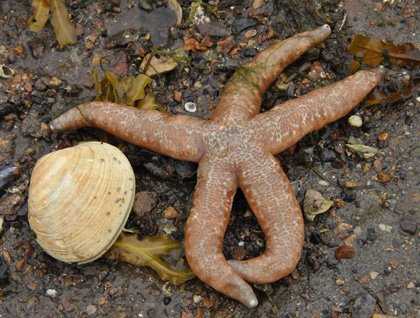We awoke this morning to find more liquid Alaskan sunshine. National Geographic Sea Lion cruised into Pavlof Harbor on the south side of Chichagof Island and dropped anchor. Originally named Gavan Pavlof (Paul’s Harbor) by Russian fur traders in the mid-19th century, the small, sheltered anchorage sits near the entrance to Freshwater Bay. This area was important to fur traders and explorers because of its easily-accessed water supply. Pavlof Lake sits above a low waterfall, where a fish ladder has been built that salmon use to make their run upstream. High clouds hovered around the snow-capped peaks in the distance.
After breakfast, we departed the vessel for our morning shore activities, which included hikes and kayaking. Some of the natural history staff and crew were already on the beach setting up the kayaks when the first arriving inflatable boat with guests spotted a brown bear nearby. The bear was remarkably close to the landing beach, so those on shore hastily boarded an inflatable boat and we watched the bear from the water instead of on shore. The bear was chasing ravens on the beach and ducking into and out of the forest. After a while, the bear wandered back to the waterfall that drains the lake and so we decided to land on the beach. With the bear so close by, it was decided that the group of hikers should all stay together, and we wandered across the intertidal zone to get a look up the inlet toward the falls. Others boarded kayaks and headed out to explore the bay as salmon leaped out of the water nearby. The hikers rounded a point and could clearly see the bear sitting on a rock with its back toward us at the base of the waterfall, inspecting salmon as they migrated upstream. The bear eventually wandered upstream in search of other things to eat, but many of us got excellent pictures of this impressive animal.
We decided that it would be prudent to hike on the other side of the inlet from where the bear was, so a large group of hikers retuned to the landing site to don life vests for a quick inflatable boat ride across the inlet. Once there, many of us hiked along the shoreline or through the temperate rain forest, where we marveled at the lush vegetation, large trees, deep mud, and abundant blueberries.
Our afternoon destination was Basket Bay on Chichagof Island. Basket Bay was named by employees of the Alaska Oil and Guano Company in 1900. The Tlingit Indian name “Kook Bay” was published in 1899 by the U.S. Coast and Geodetic Survey. We boarded inflatable boats for tours of the beautiful scenery that includes a limestone arch and grotto, complete with drooping temperate rain forest vegetation all around. Chum salmon were migrating upstream. We learned from our friendly shipboard geologist Al Trujillo that this limestone rock now present in Southeast Alaska was originally formed in shallow, tropical seas thousands of miles away about 300 million years ago. These rocks, which are part of the Alexander Terrane, have subsequently been transported by plate tectonic processes and pushed up against the edge of the continent in what would later become Alaska. A piece of limestone that contained colonial coral fossils was also found.
After diner, the ship maneuvered through the narrow passage of Peril Strait toward Sitka, our point of disembarkation. We’ve had a fabulous week of memories during our voyage throughout Southeast Alaska. Emotions flowed strongly as we bid this great land one last farewell—at least for now.







